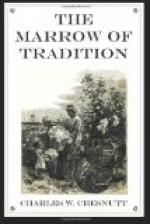Having disposed of this difference, and having observed that the white man was perhaps fifty years of age and the other not more than thirty, it may be said that they were both tall and sturdy, both well dressed, the white man with perhaps a little more distinction; both seemed from their faces and their manners to be men of culture and accustomed to the society of cultivated people. They were both handsome men, the elder representing a fine type of Anglo-Saxon, as the term is used in speaking of our composite white population; while the mulatto’s erect form, broad shoulders, clear eyes, fine teeth, and pleasingly moulded features showed nowhere any sign of that degeneration which the pessimist so sadly maintains is the inevitable heritage of mixed races.
As to their personal relations, it has already appeared that they were members of the same profession. In past years they had been teacher and pupil. Dr. Alvin Burns was professor in the famous medical college where Miller had attended lectures. The professor had taken an interest in his only colored pupil, to whom he had been attracted by his earnestness of purpose, his evident talent, and his excellent manners and fine physique. It was in part due to Dr. Burns’s friendship that Miller had won a scholarship which had enabled him, without drawing too heavily upon his father’s resources, to spend in Europe, studying in the hospitals of Paris and Vienna, the two most delightful years of his life. The same influence had strengthened his natural inclination toward operative surgery, in which Dr. Burns was a distinguished specialist of national reputation.
Miller’s father, Adam Miller, had been a thrifty colored man, the son of a slave, who, in the olden time, had bought himself with money which he had earned and saved, over and above what he had paid his master for his time. Adam Miller had inherited his father’s thrift, as well as his trade, which was that of a stevedore, or contractor for the loading and unloading of vessels at the port of Wellington. In the flush turpentine days following a few years after the civil war, he had made money. His savings, shrewdly invested, had by constant accessions become a competence. He had brought up his eldest son to the trade; the other he had given a professional education, in the proud hope that his children or his grandchildren might be gentlemen in the town where their ancestors had once been slaves.
Upon his father’s death, shortly after Dr. Miller’s return from Europe, and a year or two before the date at which this story opens, he had promptly spent part of his inheritance in founding a hospital, to which was to be added a training school for nurses, and in time perhaps a medical college and a school of pharmacy. He had been strongly tempted to leave the South, and seek a home for his family and a career for himself in the freer North, where race antagonism was less keen, or at least less oppressive, or in Europe, where he had never found his color work to his disadvantage. But his people had needed him, and he had wished to help them, and had sought by means of this institution to contribute to their uplifting. As he now informed Dr. Burns, he was returning from New York, where he had been in order to purchase equipment for his new hospital, which would soon be ready for the reception of patients.




